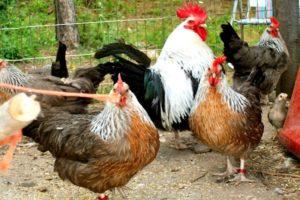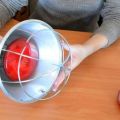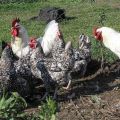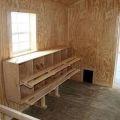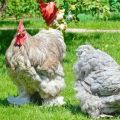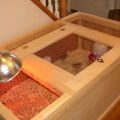Instructions for using infrared lamps for heating a chicken coop
In the cold season, chickens should not be left without adequate heating. In some cases, it is possible to do with simple insulation of the house, but sometimes heat sources are required. One of them can be an infrared lamp used to heat a chicken coop. It has many advantages over other devices. The main thing is to choose the right lamp, taking into account its type, and then follow safety precautions.
Why is it important to keep the coop warm
Temperature conditions greatly affect the health of chickens and their egg production. Ideally, the temperature should not fall below +5 degrees and rise above +18. To monitor temperature fluctuations, a thermometer is hung in the chicken coop so that the birds cannot reach it.
Careful adherence to the temperature standard is necessary for the following reasons:
- Hypothermia can cause a cold.
- Immunity worsens.
- Growth slows down.
- Egg production decreases.
- Humidity and frost can lead to arthritis.
- Overheating disrupts natural biorhythms, productivity suffers.
Without proper heating, embryos in eggs can die in winter. Temperature drops also have a negative effect on them. The warmth of the hen itself, which incubates them, does not play a special role.

Features and fundamental principles of the IR lamp
To use this device correctly and achieve the desired result, you need to know how IR lamps work. They are not much different from conventional tungsten filament bulbs.
But there are features that make the lamps well suited for heating:
- The flasks additionally contain a gaseous mixture (for example, nitrogen).
- Inside, the surface of the lamps is mirrored and plays the role of a reflector.
- A special coating allows you to focus the heat on the desired area.
- As a result, energy is saved (up to 45%).
Thanks to efficient heating and economy, infrared lamps are useful in large and private households. In contrast, red lamps are used primarily for lighting, while ultraviolet lamps are used for disinfection. These two types of lamps are not suitable for heating.
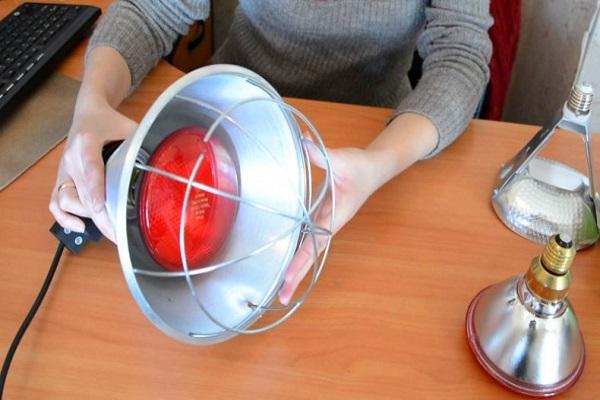
For heating
Infrared lamps do not heat the air itself, but directly the objects at which they are directed. Therefore, they warm up better, which is especially important in winter. This feature also allows the heaters to be placed directly under the ceiling.
When heating with other devices, the air is exposed, which then rises, and to maintain the temperature, the equipment must be placed as low as possible. But in chicken coops it is difficult to do this, and besides, birds can suffer if they get to the hot elements.
For lighting
Infrared lamps are not suitable for lighting, since their radiation is rather weak and decreases even more when the device is placed under the ceiling. Chickens are daytime birds. With a lack of light, they reduce activity, eat little, and the growth rate decreases. Accordingly, egg production also suffers.
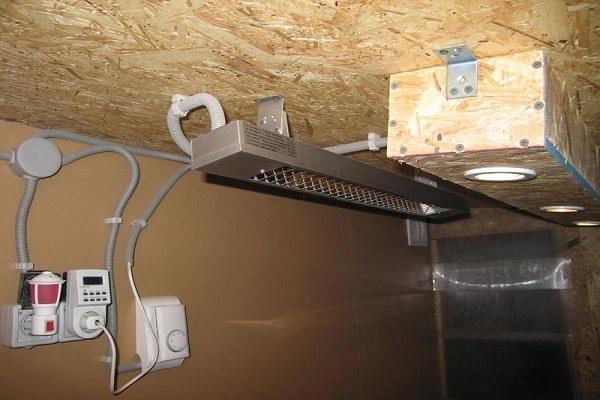
Types of infrared lamps
There are several varieties of this equipment. They are chosen depending on the size of the chicken coop and what kind of birds will be kept there.
Installed permanently
Stationary heaters are installed for a long time. Before that, you need to choose a permanent place for them. Most often this is the ceiling, since this arrangement allows you to equally heat a large area. These lamps are suitable for rooms where chickens of the same age are kept.
You can select equipment that will provide intensity control and will automatically support different thermal conditions. Some of the best options are ceramic appliances. Their material accumulates heat and emits it for a long time after switching off. This saves energy, and even if the power goes out, the birds will not freeze.
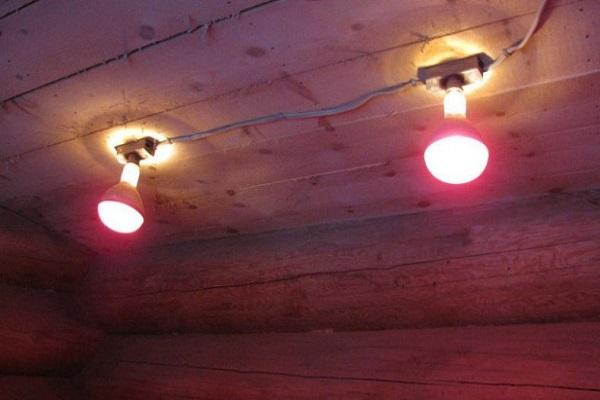
Mobile
Such heating systems can be placed anywhere, transferred from place to place, if necessary. They are usually used in small farms, when chickens and adult birds are kept in the same room.
Mobile heaters have a number of advantages and disadvantages:
- Autonomous, the design has all the necessary elements.
- No need to mount, easy to carry from place to place.
- The high cost of the device.
- Cannot be ceiling mounted.
Film
These heaters, as the name suggests, look like film. Sold in rolls, if necessary, you can cut into pieces of the desired size. It consists of two layers of foil, which are covered with a film on the outside, and heating elements between them. The set usually comes with a thermostat so that you can select the desired temperature regime. As a result, the appliance turns itself on and off when it gets too cold or hot.
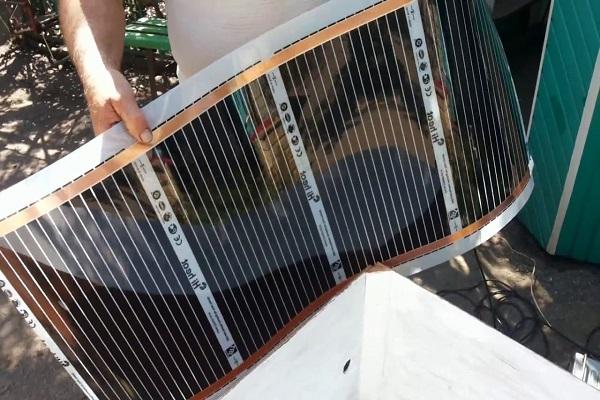
Film heaters are usually installed on the floor or ceiling. The first option is suitable for living quarters, as warm floors create a feeling of comfort. But birds often damage the structure, so in the chicken coop it is installed on the ceiling.
Panel
They usually look like flat rectangular panels with heat reflective material on the back. The front wall is a heat conductor. Inside there are various heating elements.
Such heating structures are of different types - ceramic, metal, glass. The latter are the most economical, but at the same time expensive. Best suited for a hen house ceramic. Like other heaters, they are mainly mounted on the ceiling.
Advantages and disadvantages
Infrared lamps have many advantages due to which they are used in both large and small farms:
- easy to install in the right place;
- easy to use;
- effective for heating, since heat is directed to a specific object;
- positively affect the health of animals;
- can be used even in rooms with high humidity;
- environmental friendliness - they do not burn air, do not form harmful vapors.
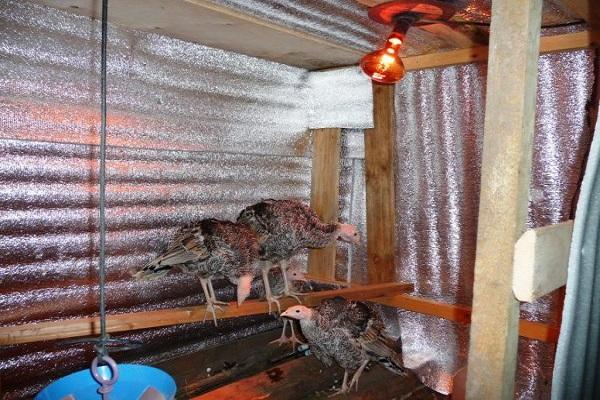
Among the disadvantages of the equipment are the following:
- quickly fail;
- high price;
- the work surface is very hot, a thermostat is required.
Profitability
Infrared lamps are quite cost-effective; they can be used to heat the chicken coop even in winter. In this case, heat is transferred directly to the chickens themselves, it is not dissipated in the air. The health of birds improves, even young ones, and egg production increases. If necessary, lamps can be positioned to heat a specific area (for example, a chicken pen), or the entire room. Electricity is also saved.
How to choose the right infrared bulb
When choosing heating devices, the following factors are taken into account:
- the area of the room (for 12 square meters you need a device with a capacity of 250 watts);
- ceiling height (the higher, the more power is required);
- shape (for spot lighting, a classic lamp is enough, for a large room panel or film are better suited);
- the presence of a thermostat;
- the duration of work must be at least 4 thousand hours.
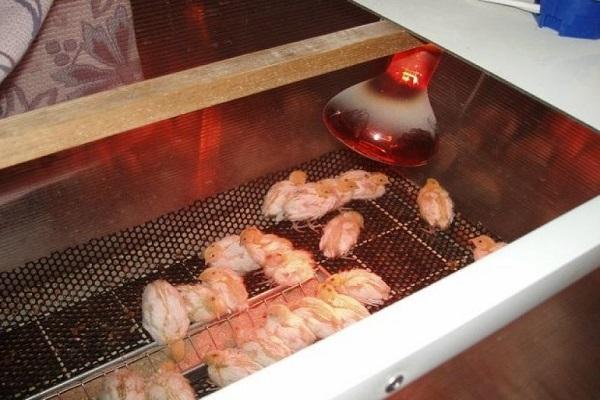
Therefore, when buying, carefully study the instructions. Adequate ventilation is also required so that the room is not stuffy. For example, they install a fan, make holes in the roof.
Security measures
Besides checking the device itself, it is important to make sure that the wiring can withstand the load. Otherwise there is a risk of short circuit. The lamps themselves are covered with a wire mesh. Otherwise, birds may be injured or damage equipment.
To avoid overheating, install all devices within a meter from objects in the chicken coop (including perches).
In general, IR lamps are an effective heating medium. Compared to other devices, they allow you to transfer heat to those objects that need it. This saves electricity.

